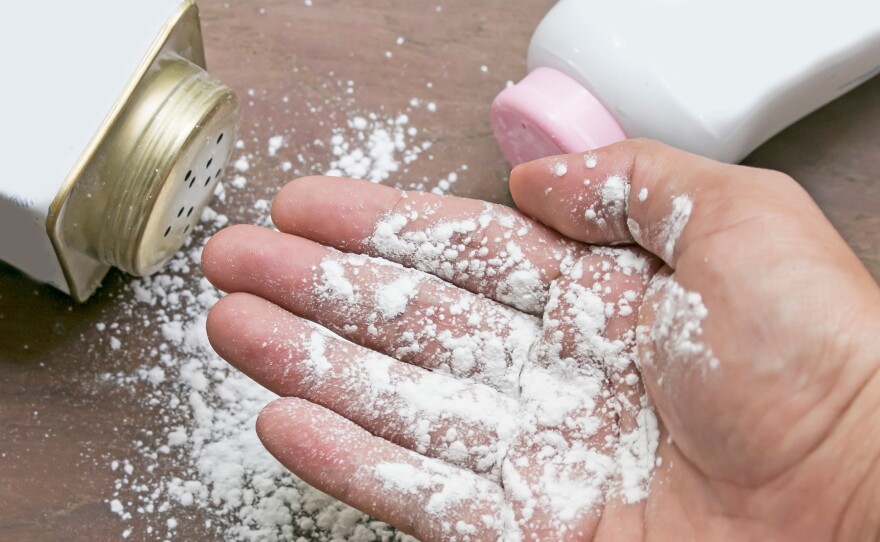In recent years, women have taken talcum powder manufacturers to court over concerns that the use of the product in the genital area could cause ovarian cancer. Now, a new study finds no meaningful association between using talc-based or other powders and ovarian cancer.
Researchers from NIH's National Institute of Environmental Health Sciences and the National Cancer Institute conducted the largest study to date of genital powder use and ovarian cancer. The study, published Tuesday in JAMA, used data from 252,745 women who answered questions about whether they used powder on their genitals. This was a pooled analysis of four large studies gathering data about the frequency and length of time women used the powder.
According to epidemiologist Katie O'Brien who headed the study, women report applying the powder either directly on their genital area or on sanitary napkins, tampons, underwear or diaphragms. O'Brien doesn't know exactly which type of powder women used. It could have been talcum powder alone, cornstarch alone or a combination of both.
The research finds that women who had ever used powder had an 8% increased risk of ovarian cancer compared to those who never used it. "That is not a statistically significant increase" says O'Brien. And she adds that this increase needs to be understood in context. Ovarian cancer is very rare and the lifetime risk of getting it is 1.3% so an increase of 8% to that is "small." O'Brien says it represents an estimated 0.09% increase in risk by age 70.
But among the subset of women who had their uterus and fallopian tubes intact, their increased risk of ovarian cancer from using powder in their genital area was 13% — which is an estimated 0.15% increase in risk by age 70 and is still considered a very small increase.
Unlike most other studies of talc and ovarian cancer, which focused on women already diagnosed with cancer, this study was prospective, and asked about powder use before study subjects had developed ovarian cancer. This means the study is free from recall bias, says O'Brien. It removes the likelihood that study subjects "search for reasons why they have ovarian cancer, and may over-report certain things they have heard may be associated with it."
Rates of powder use have declined over the last 50 years, yet it remains a routine practice for some women, says Dr. Dana Gossett, a professor of obstetrics and gynecology at the University of California, San Francisco. She wrote an editorial accompanying the study but was not involved in the study itself.
"Women have used powders for genital hygiene for decades to absorb odor and moisture," she says.
Earlier investigations of an association between the use of talc-containing powders for genital hygiene and epithelial ovarian cancer risks have provided inconsistent results, says Gossett and have resulted in an "ongoing controversy." Concerns have been raised about possible contamination of mineral talc with asbestos, a known cancer risk. Most powder products include some mineral talc.
Researchers say it's been hypothesized that the powder could induce an inflammatory response by irritating epithelial ovarian tissue or fallopian tubes directly which, in turn, could set off a cascade of increased oxidative stress levels, DNA damage and cell division, all of which could contribute to carcinogenesis.
Gossett says the new study finding "doesn't really support any association [of powder use with ovarian cancer]."
"No study can ever say definitively what the cause of cancer is, but this study at least shows there's not a substantial increase in ovarian cancer risk," she says.
The study has several limitations. Researchers were not able to document how frequently or how long women used powder nor were they able to identify exactly what ingredients were in the powder. It also included mostly white women. Anecdotally, black women are more likely to use baby powder.
Obstetrician Gossett says the study findings should be "reassuring to women that if they are choosing to use powders on their genitals that they're not doing something horrendous."
Gossett also notes that due to the very small number of cancer cases in the data, the study was "underpowered." She suggests that future analyses would be strengthened by focusing on women with intact reproductive tracts, with particular attention to timing and duration of exposure to powder in the genital area.
In the meantime, since there's no medical reason to use talcum powder, researcher O'Brien suggests women weigh perceived benefit with possible risk. Study participants will continue to be followed to track ovarian cancer development in the future, she says.
Copyright 2020 NPR. To see more, visit https://www.npr.org.






